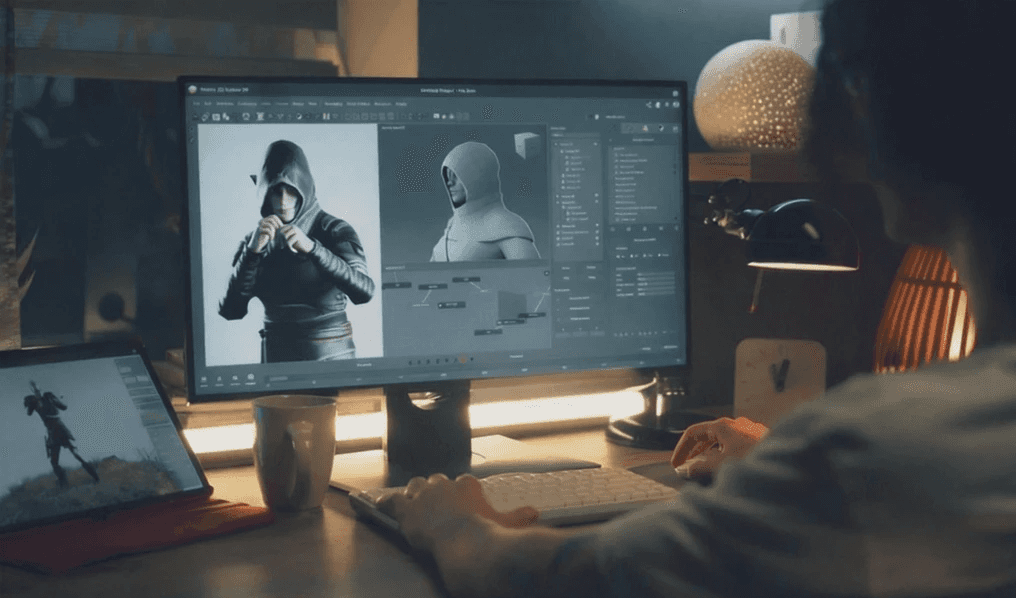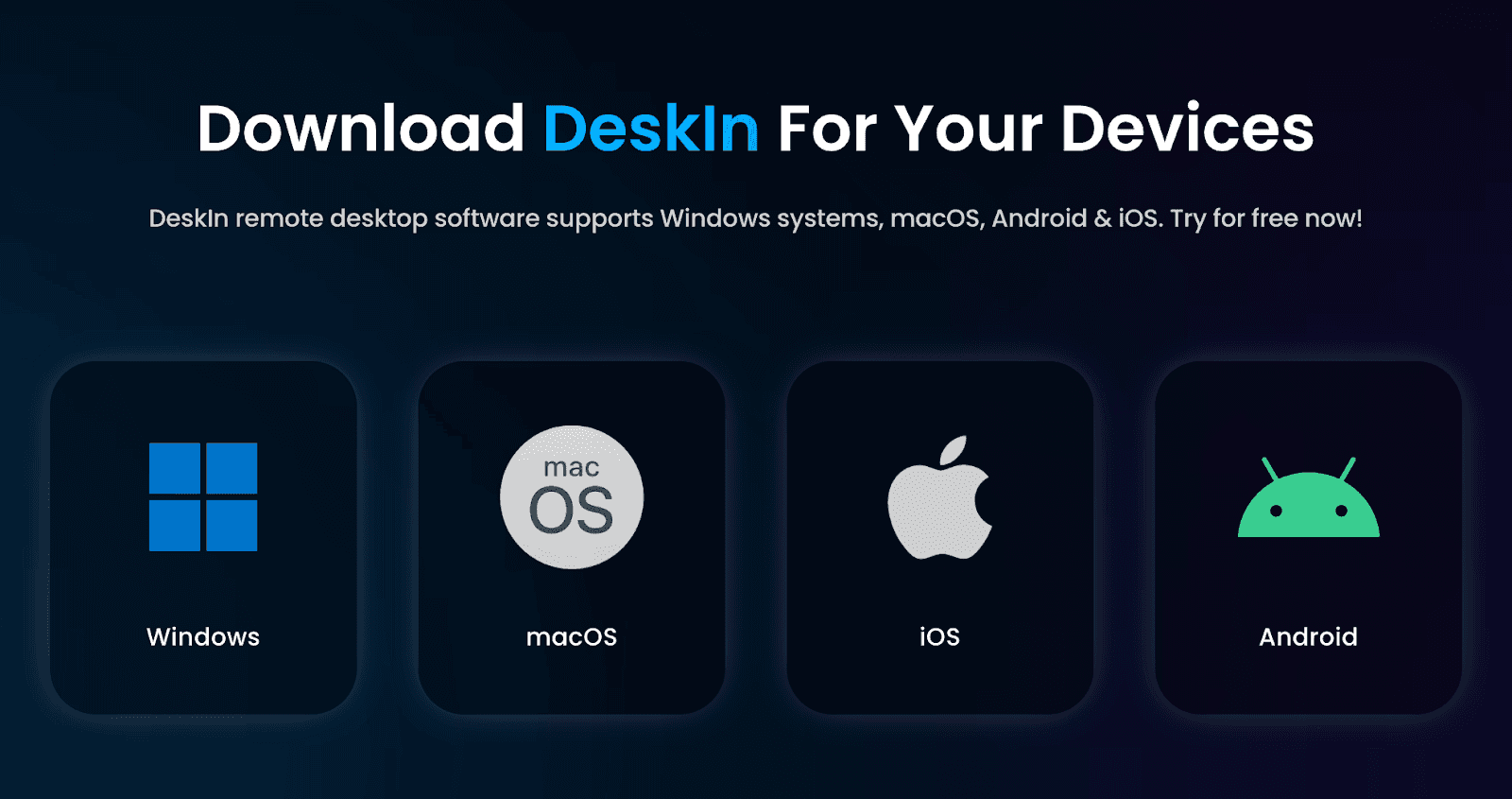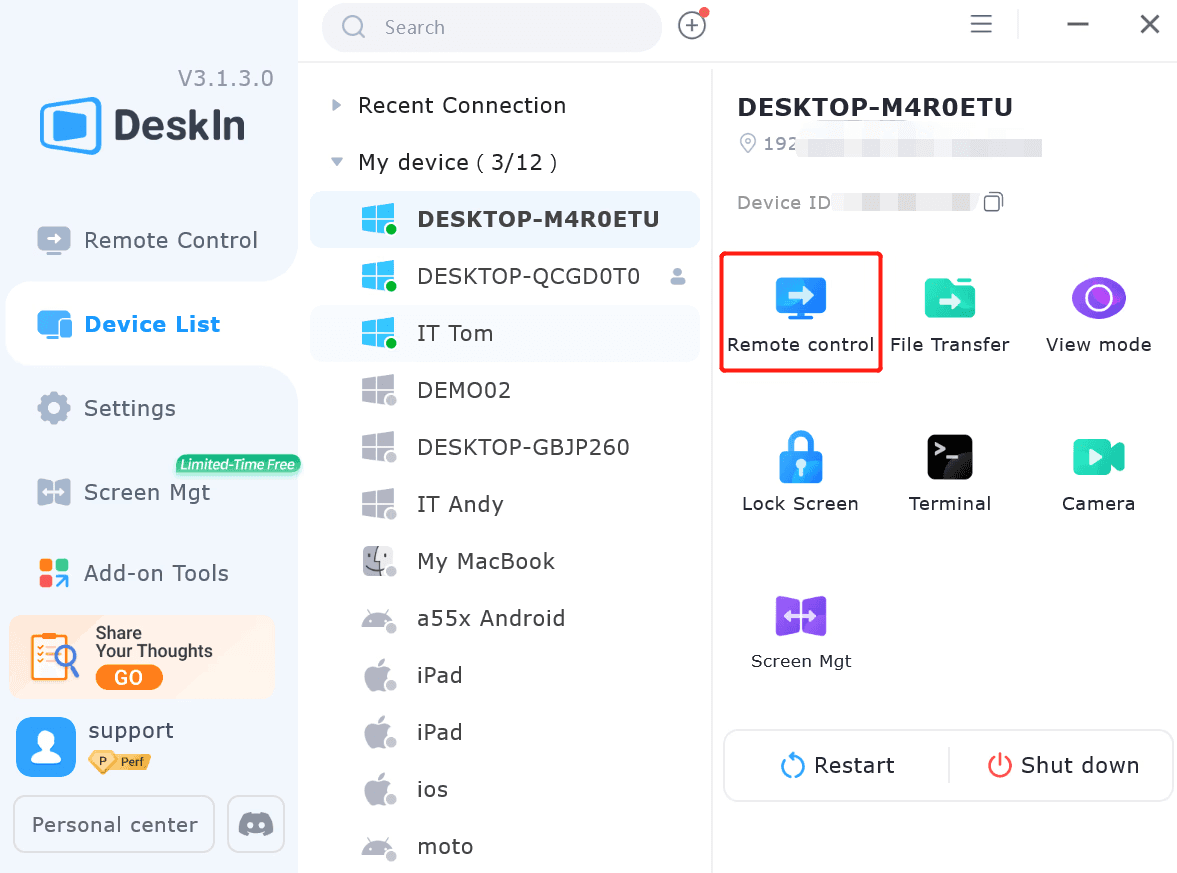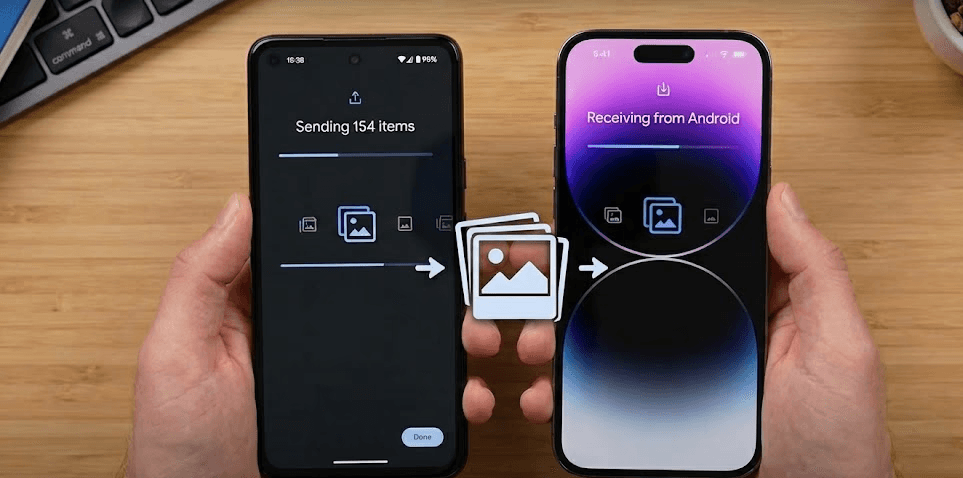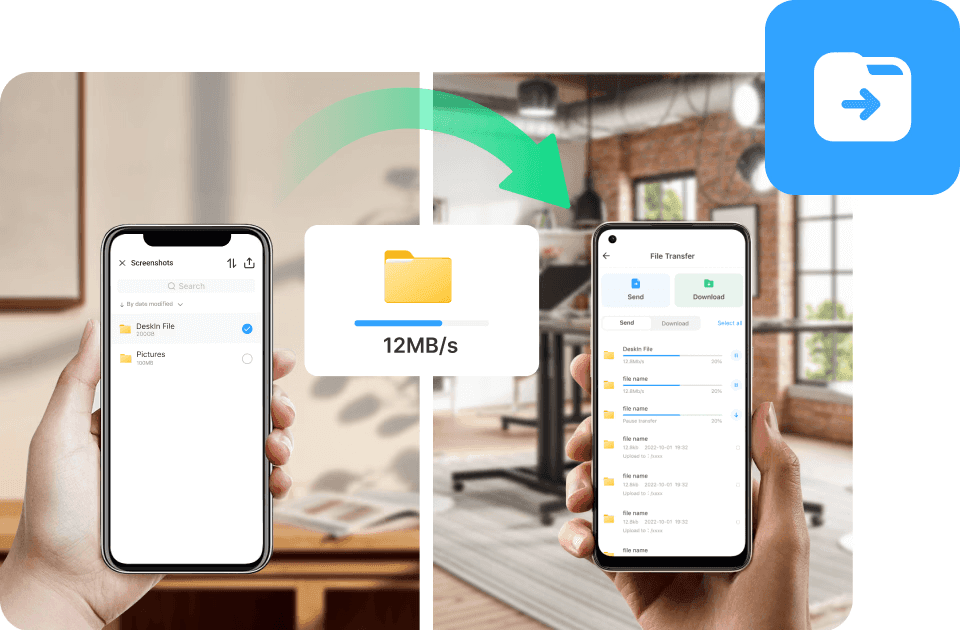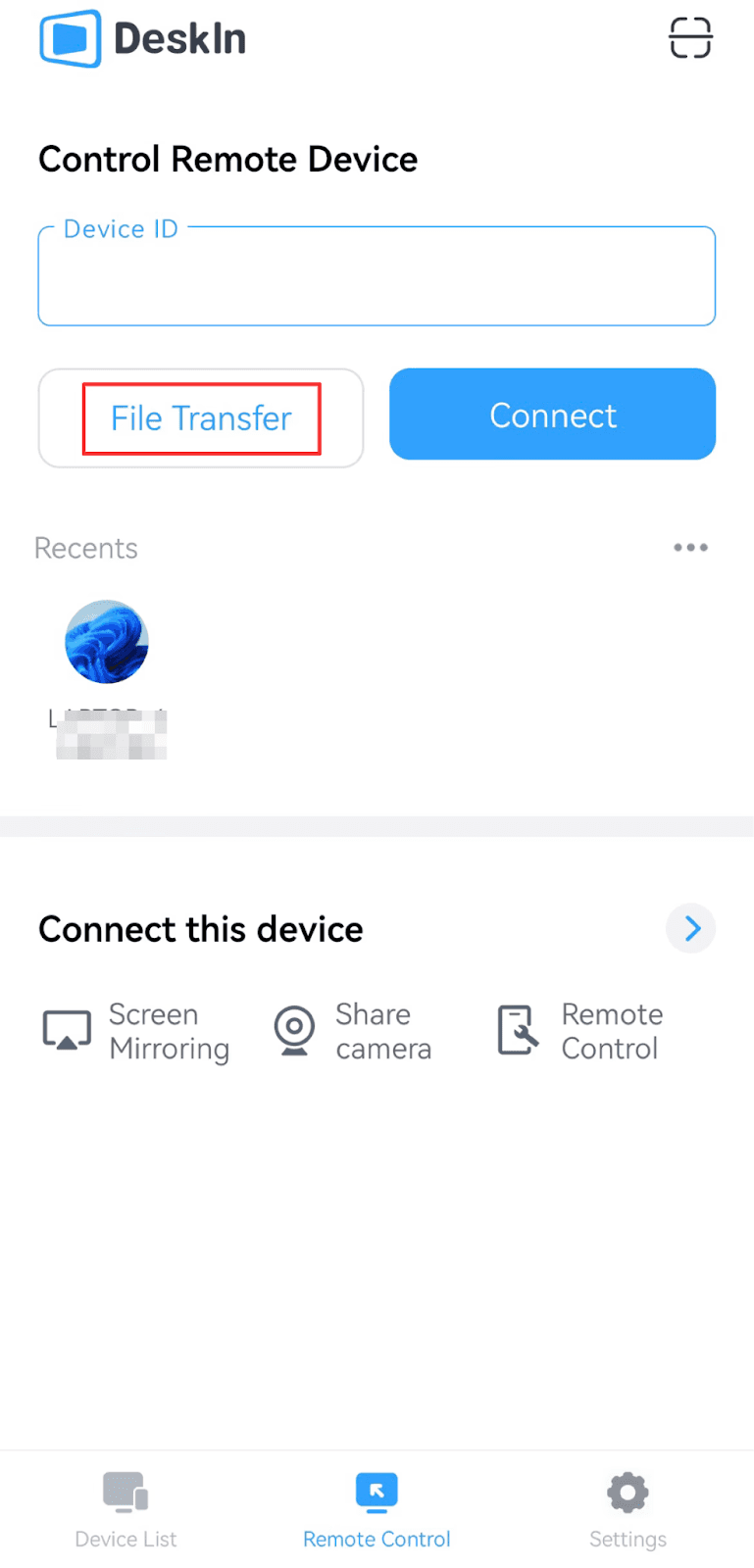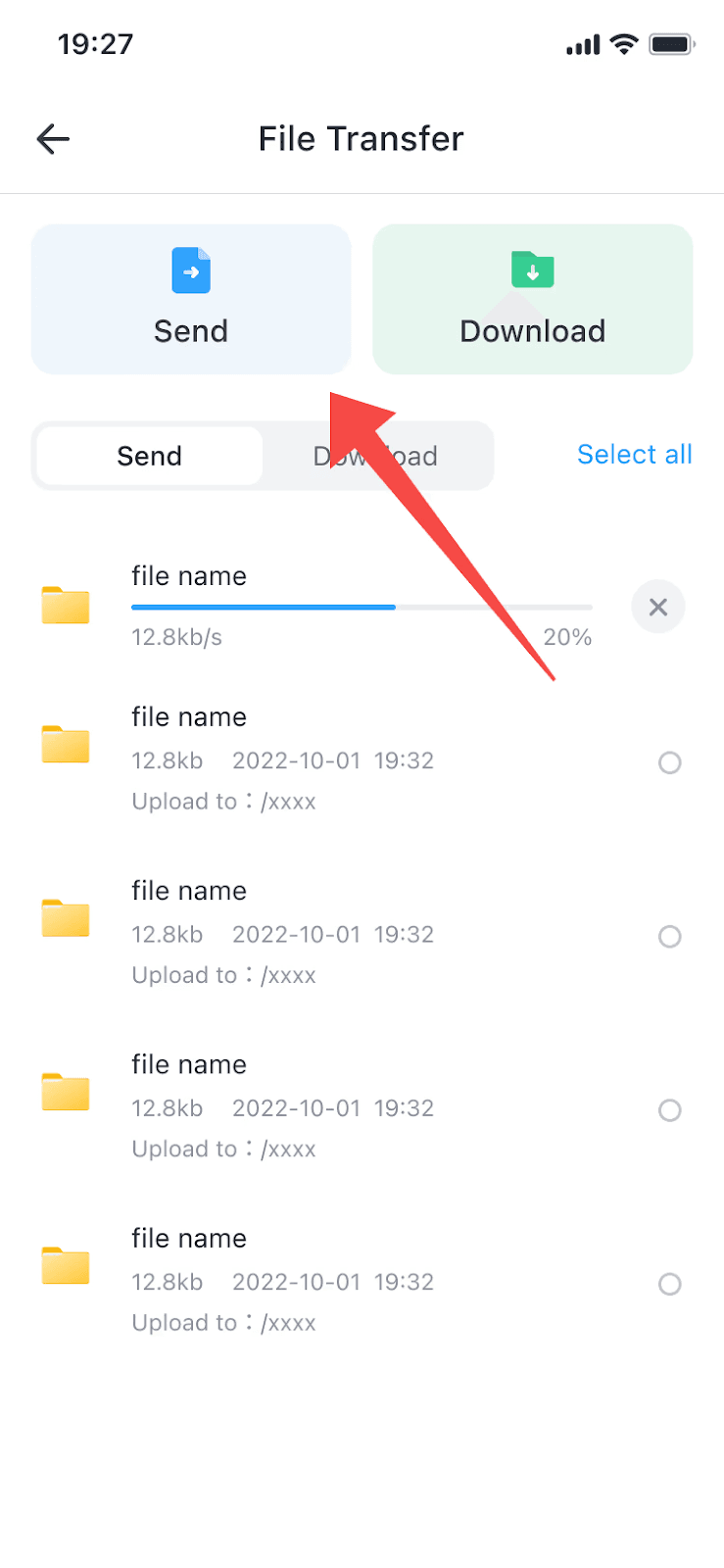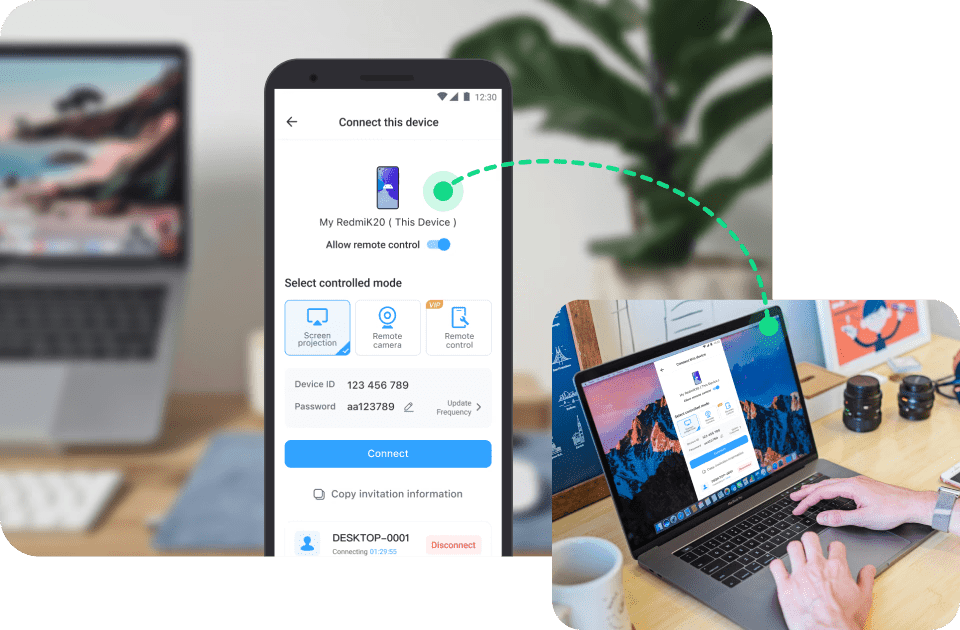Cách Kết Nối Điện Thoại Android với PC: Những Cách Dễ Dàng và Cách Khắc Phục Sự Cố
Kết nối Android với PC không chỉ đơn thuần là chuyển ảnh — mà còn là một cách thông minh để tăng năng suất, đơn giản hóa việc truy cập tệp và thậm chí điều khiển các thiết bị của bạn từ xa. Dù bạn đang làm việc từ xa, học tập hay chơi game, một kết nối Android với PC vững chắc có thể làm cho các tác vụ hàng ngày nhanh chóng và dễ dàng hơn.
Trong hướng dẫn này, chúng tôi sẽ chỉ cho bạn những cách dễ nhất để kết nối điện thoại của bạn với PC, sử dụng USB, Microsoft Phone Link, hoặc sử dụng DeskIn, một công cụ mạnh mẽ giúp bạn kết nối Android với PC không dây. Bắt đầu nào!
👀 Đọc Thêm:
Cách Kết Nối Hai Điện Thoại Android Từ Xa [Cách Đã Kiểm Tra]
Cách Kết Nối Thiết Bị Android với MacBook/iMac Một Cách Dễ Dàng
Cách Thức Truyền Thống Để Kết Nối Thiết Bị Android với PC
Các cách phổ biến nhất để kết nối thiết bị Android với PC vẫn là các phương pháp truyền thống — sử dụng cáp USB hoặc ứng dụng Phone Link tích hợp sẵn của Microsoft. Những phương pháp này dễ thiết lập và lý tưởng cho việc chuyển tệp, xem thông báo, hoặc đồng bộ hóa dữ liệu cơ bản giữa các thiết bị.
Sử Dụng Cáp USB
Kết nối điện thoại Android của bạn với PC bằng cáp USB là một trong những phương pháp đơn giản và đáng tin cậy nhất. Nó cho phép truyền dữ liệu tốc độ cao mà không cần kết nối internet, và nó hoạt động trên hầu hết tất cả các thiết bị Android và Windows. Dưới đây là cách bạn có thể làm điều đó:
Bước 1. Sử dụng một cáp USB tương thích (tốt nhất là cáp gốc) để kết nối điện thoại Android của bạn với PC.
Bước 2. Trên điện thoại của bạn, một thông báo sẽ xuất hiện. Nhấn "Sạc thiết bị này qua USB", sau đó chọn "Chuyển tệp" (MTP) từ danh sách tùy chọn USB.
Bước 3. Trên PC của bạn, mở "File Explorer". Thiết bị Android của bạn sẽ xuất hiện dưới "Thiết bị và Ổ đĩa."
Bước 4. Nhấp vào thiết bị để duyệt bộ nhớ trong hoặc thẻ SD, sau đó kéo và thả tệp giữa các thiết bị.

📌 Mẹo & Các Vấn Đề Thông Thường:
Kết nối không hiển thị? Kéo thông báo xuống và chọn chế độ USB một cách thủ công.
Không thể kết nối với pc? Thử một cổng USB hoặc cáp khác, đặc biệt là nếu bạn đang sử dụng bộ sạc của bên thứ ba.
Chưa cài đặt driver? Windows có thể cần cài đặt driver USB Android tự động. Nếu không, kiểm tra trang web của nhà sản xuất.
Sử Dụng Ứng Dụng Microsoft Phone Link
Nếu bạn muốn kết nối điện thoại Android của mình với PC không dây, ứng dụng Microsoft Phone Link cung cấp một giải pháp gốc tuyệt vời cho việc đồng bộ hóa tin nhắn, cuộc gọi và phương tiện, đặc biệt hữu ích cho những người thường xuyên chuyển đổi giữa các thiết bị.
Trước khi bạn bắt đầu, hãy chắc chắn rằng PC của bạn được cập nhật lên Windows 10 (cập nhật tháng 10 năm 2018 hoặc mới hơn) hoặc Windows 11, thiết bị Android của bạn chạy Android 7.0 hoặc phiên bản mới hơn, và cả hai thiết bị đều được kết nối với cùng một mạng Wi-Fi.
Bước 1. Trên PC Windows 10 hoặc 11 của bạn, mở hoặc cài đặt ứng dụng Phone Link (đã cài sẵn trên hầu hết các thiết bị).
Bước 2. Trên điện thoại Android của bạn, tải ứng dụng Link to Windows từ Google Play. Một số điện thoại (như Samsung Galaxy) có thể đã có nó tích hợp sẵn.
Bước 3. Mở cả hai ứng dụng, sau đó đăng nhập bằng tài khoản Microsoft của bạn hoặc quét mã QR hiển thị trên PC để ghép nối các thiết bị.
Bước 4. Khi đã ghép nối, bạn có thể xem và phản hồi tin nhắn, kiểm tra thông báo, xem ảnh gần đây và thậm chí thực hiện cuộc gọi điện thoại trực tiếp từ PC của bạn.

📌 Hạn Chế hoặc Thiếu Sót:
Ứng dụng này không hỗ trợ truy cập đầy đủ vào trình quản lý tệp (bạn có thể xem ảnh gần đây nhưng không thể duyệt toàn bộ thư mục).
Không hỗ trợ điều khiển từ xa hoặc phản chiếu màn hình, trừ khi bạn đang sử dụng các thiết bị Samsung hoặc Surface Duo chọn lọc với các tính năng tích hợp bổ sung.
Không thể sử dụng cho việc chuyển tệp lớn — đối với điều đó, một ứng dụng của bên thứ ba tuyệt vời cung cấp nhiều tính linh hoạt hơn. Hãy đọc tiếp để khám phá.
Lựa Chọn Tốt Nhất: Sử Dụng DeskIn Để Kết Nối Android-PC Không Gián Đoạn
Mặc dù việc sử dụng cáp USB hoặc Microsoft Phone Link có thể giúp bạn kết nối Android với PC, cả hai đều có nhược điểm riêng. Chuyển tệp USB cần truy cập vật lý và cáp, trong khi Phone Link có tính năng hạn chế và chỉ hoạt động đáng tin cậy trên các thiết bị chọn lọc.
Nếu bạn đang tìm kiếm nhiều tính linh hoạt hơn, tốc độ và khả năng chức năng, một giải pháp của bên thứ ba như DeskIn là một lựa chọn tốt hơn nhiều. Nó là một ứng dụng đa nền tảng mạnh mẽ cho phép điều khiển từ xa không dây, chuyển tệp, và chia sẻ màn hình giữa điện thoại Android và PC. Dù bạn đang làm việc từ xa, chơi game, hoặc chỉ đơn giản là cố gắng di chuyển tệp mà không có giới hạn, DeskIn cung cấp một kết nối mượt mà và an toàn, ngay cả trên các mạng yếu như điểm phát sóng hoặc Wi-Fi công cộng.

📌 Khám Phá Thêm Tại DeskIn
Điều Khiển Từ Xa: Hoàn toàn điều khiển thiết bị Android hoặc PC của bạn từ một thiết bị khác, hỗ trợ cử chỉ cảm ứng, nhập liệu bằng bàn phím và điều khiển trò chơi.
Chuyển Tệp: Chuyển tệp lớn với tốc độ lên tới 12MB/s, không có giới hạn về loại hoặc kích thước tệp.
Bảo Vệ Quyền Riêng Tư: Bao gồm chế độ màn hình bảo mật, quản lý truy cập thiết bị (đưa vào danh sách đen/trắng), và xác minh email để tăng cường bảo mật.
Truy Cập Đa Nền Tảng: Kết nối qua tất cả các hệ thống chính — Android, iOS, Windows và macOS — và thậm chí sử dụng máy tính bảng hoặc điện thoại của bạn như một màn hình phụ.
Các Công Cụ Bổ Sung: Các tính năng như màn hình ảo, truy cập camera từ xa, mở rộng nhiều màn hình, và phản chiếu màn hình theo thời gian thực khiến nó lý tưởng cho người dùng mạnh, người sáng tạo và khách du lịch.
Tất cả những tính năng lấp lánh này đã khiến DeskIn trở thành phần mềm truy cập từ xa tốt nhất cho Windows PC và điện thoại di động. Bây giờ, hãy xem cách kết nối Android với PC bằng DeskIn trong các bước dễ thực hiện.
Bước 1. Tải Xuống và Cài Đặt DeskIn
Truy cập trang web chính thức của DeskIn trên cả điện thoại Android và PC của bạn. Tải xuống phiên bản phù hợp cho mỗi thiết bị và hoàn tất quá trình cài đặt. nhấp vào đây để tải xuống
Bước 2. Tạo và Đăng Nhập Vào Tài Khoản DeskIn của Bạn
Mở ứng dụng DeskIn trên cả hai thiết bị và đăng nhập bằng cùng một tài khoản. Nếu bạn là người mới, hãy đăng ký bằng địa chỉ email của bạn — bạn sẽ cần xác minh điều này để đảm bảo an toàn.
Bước 3. Liên Kết Các Thiết Bị và Chọn Chế Độ Kết Nối
Sau khi đã đăng nhập, bạn sẽ thấy ID thiết bị và mật khẩu của thiết bị Android của bạn. Nhập chúng trên PC của bạn, và khi chúng được kết nối thành công, bạn có thể khám phá các tính năng dưới Kết nối:
Điều Khiển Từ Xa – Hoàn toàn điều khiển PC hoặc Android của bạn từ xa.
Chuyển Tệp – Gửi tệp nhanh chóng giữa các thiết bị.
Chia Sẻ Màn Hình – Phản chiếu màn hình của bạn theo thời gian thực.

Bước 4. Bắt Đầu Kết Nối
Nhấp vào chức năng bạn muốn sử dụng và làm theo các hướng dẫn để khởi động phiên. DeskIn sẽ tự động thiết lập một kết nối an toàn. Tùy thuộc vào nhu cầu của bạn, bạn có thể kích hoạt các tính năng bổ sung như màn hình ảo, chế độ quyền riêng tư hoặc camera từ xa trong phần cài đặt ứng dụng.
Sự So Sánh Ngắn Gọn Các Cách Kết Nối Android với PC
Giờ đây, bạn đã tìm hiểu về DeskIn và các tính năng mạnh mẽ của nó, hãy cùng dành một chút thời gian để so sánh nó với các phương pháp truyền thống khác để kết nối Android với PC. Dưới đây là bảng chi tiết nêu rõ ưu và nhược điểm của từng phương pháp kết nối, giúp bạn đưa ra lựa chọn thông minh dựa trên nhu cầu và sở thích của mình.
Phương Pháp | Tốc Độ | Dễ Sử Dụng | Bảo Mật | Giới Hạn Tệp | Các Tính Năng Bổ Sung |
|---|---|---|---|---|---|
Cáp USB | Cao (lên đến 5 Gbps) | Vừa (cần cáp) | Cao (không cần internet) | Không (truy cập trực tiếp) | Truy cập tệp trực tiếp, đáng tin cậy cho các chuyển tệp lớn |
Microsoft Phone Link | Trung bình (phụ thuộc vào Wi-Fi) | Cao (thiết lập dễ dàng với tài khoản Microsoft) | Cao (bảo mật tài khoản Microsoft) | Có (các loại tệp hạn chế) | Cuộc gọi, SMS, đồng bộ hóa phương tiện, thông báo trên PC |
DeskIn | Cao (lên đến 12MB/s) | Rất Cao (thiết lập dễ dàng, không cần cáp) | Cao (xác minh email, chế độ quyền riêng tư) | Không (kích thước không giới hạn) | Điều khiển từ xa, màn hình phụ, màn hình ảo, camera từ xa, hỗ trợ đa nền tảng, v.v. |
Các Câu Hỏi Thường Gặp Về Kết Nối Điện Thoại Android với PC/ Máy Tính
Tôi phải làm gì để sửa lỗi điện thoại Android không kết nối được với PC?
Nếu điện thoại Android của bạn không kết nối được với PC, hãy đảm bảo rằng cáp USB của bạn đang hoạt động và bạn đã cài đặt đúng driver. Kiểm tra xem chế độ USB trên điện thoại của bạn đã được đặt thành "Chuyển tệp" (MTP) hay chưa, và thử khởi động lại cả hai thiết bị. Nếu bạn đang sử dụng kết nối không dây, hãy đảm bảo cả hai thiết bị đang ở trên cùng một mạng Wi-Fi.
Tôi có thể sử dụng điện thoại Android của mình như một màn hình phụ cho PC không?
Có, với DeskIn, bạn có thể dễ dàng sử dụng điện thoại Android của mình như một màn hình phụ cho PC. Điều này có thể giúp tăng năng suất bằng cách cung cấp thêm không gian màn hình cho đa nhiệm.
Làm thế nào tôi có thể chuyển các tệp lớn từ Android sang PC?
Nếu bạn đang chuyển các tệp lớn, DeskIn cung cấp một cách nhanh chóng và an toàn để di chuyển tệp với tốc độ lên đến 12MB/s mà không có giới hạn về kích thước tệp. Ngoài ra, việc sử dụng cáp USB hoặc Microsoft Phone Link có thể chậm hơn và có giới hạn kích thước tệp.
Kết Luận
Có nhiều phương pháp có sẵn để kết nối điện thoại Android của bạn với PC, mỗi phương pháp phù hợp với các nhu cầu khác nhau. Trong khi cáp USB và Microsoft Phone Link rất tốt cho các tác vụ cơ bản như chuyển tệp và đồng bộ hóa tin nhắn, chúng có những hạn chế về tính linh hoạt và chức năng nâng cao.
Để có một giải pháp liền mạch, toàn diện cung cấp đầy đủ kiểm soát, chuyển tệp nhanh và năng suất giữa các thiết bị, DeskIn là sự lựa chọn tốt nhất. Dù bạn đang làm việc từ xa, chơi game, hoặc quản lý tệp, DeskIn cung cấp một trải nghiệm mượt mà và mạnh mẽ trên tất cả các thiết bị. Hãy thử ngay, mở khóa các tính năng của nó và kết nối Android với PC để nâng cao công việc và giải trí của bạn ngay lập tức!
Cách Kết Nối Điện Thoại Android với PC: Những Cách Dễ Dàng và Cách Khắc Phục Sự Cố
Kết nối Android với PC không chỉ đơn thuần là chuyển ảnh — mà còn là một cách thông minh để tăng năng suất, đơn giản hóa việc truy cập tệp và thậm chí điều khiển các thiết bị của bạn từ xa. Dù bạn đang làm việc từ xa, học tập hay chơi game, một kết nối Android với PC vững chắc có thể làm cho các tác vụ hàng ngày nhanh chóng và dễ dàng hơn.
Trong hướng dẫn này, chúng tôi sẽ chỉ cho bạn những cách dễ nhất để kết nối điện thoại của bạn với PC, sử dụng USB, Microsoft Phone Link, hoặc sử dụng DeskIn, một công cụ mạnh mẽ giúp bạn kết nối Android với PC không dây. Bắt đầu nào!
👀 Đọc Thêm:
Cách Kết Nối Hai Điện Thoại Android Từ Xa [Cách Đã Kiểm Tra]
Cách Kết Nối Thiết Bị Android với MacBook/iMac Một Cách Dễ Dàng
Cách Thức Truyền Thống Để Kết Nối Thiết Bị Android với PC
Các cách phổ biến nhất để kết nối thiết bị Android với PC vẫn là các phương pháp truyền thống — sử dụng cáp USB hoặc ứng dụng Phone Link tích hợp sẵn của Microsoft. Những phương pháp này dễ thiết lập và lý tưởng cho việc chuyển tệp, xem thông báo, hoặc đồng bộ hóa dữ liệu cơ bản giữa các thiết bị.
Sử Dụng Cáp USB
Kết nối điện thoại Android của bạn với PC bằng cáp USB là một trong những phương pháp đơn giản và đáng tin cậy nhất. Nó cho phép truyền dữ liệu tốc độ cao mà không cần kết nối internet, và nó hoạt động trên hầu hết tất cả các thiết bị Android và Windows. Dưới đây là cách bạn có thể làm điều đó:
Bước 1. Sử dụng một cáp USB tương thích (tốt nhất là cáp gốc) để kết nối điện thoại Android của bạn với PC.
Bước 2. Trên điện thoại của bạn, một thông báo sẽ xuất hiện. Nhấn "Sạc thiết bị này qua USB", sau đó chọn "Chuyển tệp" (MTP) từ danh sách tùy chọn USB.
Bước 3. Trên PC của bạn, mở "File Explorer". Thiết bị Android của bạn sẽ xuất hiện dưới "Thiết bị và Ổ đĩa."
Bước 4. Nhấp vào thiết bị để duyệt bộ nhớ trong hoặc thẻ SD, sau đó kéo và thả tệp giữa các thiết bị.

📌 Mẹo & Các Vấn Đề Thông Thường:
Kết nối không hiển thị? Kéo thông báo xuống và chọn chế độ USB một cách thủ công.
Không thể kết nối với pc? Thử một cổng USB hoặc cáp khác, đặc biệt là nếu bạn đang sử dụng bộ sạc của bên thứ ba.
Chưa cài đặt driver? Windows có thể cần cài đặt driver USB Android tự động. Nếu không, kiểm tra trang web của nhà sản xuất.
Sử Dụng Ứng Dụng Microsoft Phone Link
Nếu bạn muốn kết nối điện thoại Android của mình với PC không dây, ứng dụng Microsoft Phone Link cung cấp một giải pháp gốc tuyệt vời cho việc đồng bộ hóa tin nhắn, cuộc gọi và phương tiện, đặc biệt hữu ích cho những người thường xuyên chuyển đổi giữa các thiết bị.
Trước khi bạn bắt đầu, hãy chắc chắn rằng PC của bạn được cập nhật lên Windows 10 (cập nhật tháng 10 năm 2018 hoặc mới hơn) hoặc Windows 11, thiết bị Android của bạn chạy Android 7.0 hoặc phiên bản mới hơn, và cả hai thiết bị đều được kết nối với cùng một mạng Wi-Fi.
Bước 1. Trên PC Windows 10 hoặc 11 của bạn, mở hoặc cài đặt ứng dụng Phone Link (đã cài sẵn trên hầu hết các thiết bị).
Bước 2. Trên điện thoại Android của bạn, tải ứng dụng Link to Windows từ Google Play. Một số điện thoại (như Samsung Galaxy) có thể đã có nó tích hợp sẵn.
Bước 3. Mở cả hai ứng dụng, sau đó đăng nhập bằng tài khoản Microsoft của bạn hoặc quét mã QR hiển thị trên PC để ghép nối các thiết bị.
Bước 4. Khi đã ghép nối, bạn có thể xem và phản hồi tin nhắn, kiểm tra thông báo, xem ảnh gần đây và thậm chí thực hiện cuộc gọi điện thoại trực tiếp từ PC của bạn.

📌 Hạn Chế hoặc Thiếu Sót:
Ứng dụng này không hỗ trợ truy cập đầy đủ vào trình quản lý tệp (bạn có thể xem ảnh gần đây nhưng không thể duyệt toàn bộ thư mục).
Không hỗ trợ điều khiển từ xa hoặc phản chiếu màn hình, trừ khi bạn đang sử dụng các thiết bị Samsung hoặc Surface Duo chọn lọc với các tính năng tích hợp bổ sung.
Không thể sử dụng cho việc chuyển tệp lớn — đối với điều đó, một ứng dụng của bên thứ ba tuyệt vời cung cấp nhiều tính linh hoạt hơn. Hãy đọc tiếp để khám phá.
Lựa Chọn Tốt Nhất: Sử Dụng DeskIn Để Kết Nối Android-PC Không Gián Đoạn
Mặc dù việc sử dụng cáp USB hoặc Microsoft Phone Link có thể giúp bạn kết nối Android với PC, cả hai đều có nhược điểm riêng. Chuyển tệp USB cần truy cập vật lý và cáp, trong khi Phone Link có tính năng hạn chế và chỉ hoạt động đáng tin cậy trên các thiết bị chọn lọc.
Nếu bạn đang tìm kiếm nhiều tính linh hoạt hơn, tốc độ và khả năng chức năng, một giải pháp của bên thứ ba như DeskIn là một lựa chọn tốt hơn nhiều. Nó là một ứng dụng đa nền tảng mạnh mẽ cho phép điều khiển từ xa không dây, chuyển tệp, và chia sẻ màn hình giữa điện thoại Android và PC. Dù bạn đang làm việc từ xa, chơi game, hoặc chỉ đơn giản là cố gắng di chuyển tệp mà không có giới hạn, DeskIn cung cấp một kết nối mượt mà và an toàn, ngay cả trên các mạng yếu như điểm phát sóng hoặc Wi-Fi công cộng.

📌 Khám Phá Thêm Tại DeskIn
Điều Khiển Từ Xa: Hoàn toàn điều khiển thiết bị Android hoặc PC của bạn từ một thiết bị khác, hỗ trợ cử chỉ cảm ứng, nhập liệu bằng bàn phím và điều khiển trò chơi.
Chuyển Tệp: Chuyển tệp lớn với tốc độ lên tới 12MB/s, không có giới hạn về loại hoặc kích thước tệp.
Bảo Vệ Quyền Riêng Tư: Bao gồm chế độ màn hình bảo mật, quản lý truy cập thiết bị (đưa vào danh sách đen/trắng), và xác minh email để tăng cường bảo mật.
Truy Cập Đa Nền Tảng: Kết nối qua tất cả các hệ thống chính — Android, iOS, Windows và macOS — và thậm chí sử dụng máy tính bảng hoặc điện thoại của bạn như một màn hình phụ.
Các Công Cụ Bổ Sung: Các tính năng như màn hình ảo, truy cập camera từ xa, mở rộng nhiều màn hình, và phản chiếu màn hình theo thời gian thực khiến nó lý tưởng cho người dùng mạnh, người sáng tạo và khách du lịch.
Tất cả những tính năng lấp lánh này đã khiến DeskIn trở thành phần mềm truy cập từ xa tốt nhất cho Windows PC và điện thoại di động. Bây giờ, hãy xem cách kết nối Android với PC bằng DeskIn trong các bước dễ thực hiện.
Bước 1. Tải Xuống và Cài Đặt DeskIn
Truy cập trang web chính thức của DeskIn trên cả điện thoại Android và PC của bạn. Tải xuống phiên bản phù hợp cho mỗi thiết bị và hoàn tất quá trình cài đặt. nhấp vào đây để tải xuống
Bước 2. Tạo và Đăng Nhập Vào Tài Khoản DeskIn của Bạn
Mở ứng dụng DeskIn trên cả hai thiết bị và đăng nhập bằng cùng một tài khoản. Nếu bạn là người mới, hãy đăng ký bằng địa chỉ email của bạn — bạn sẽ cần xác minh điều này để đảm bảo an toàn.
Bước 3. Liên Kết Các Thiết Bị và Chọn Chế Độ Kết Nối
Sau khi đã đăng nhập, bạn sẽ thấy ID thiết bị và mật khẩu của thiết bị Android của bạn. Nhập chúng trên PC của bạn, và khi chúng được kết nối thành công, bạn có thể khám phá các tính năng dưới Kết nối:
Điều Khiển Từ Xa – Hoàn toàn điều khiển PC hoặc Android của bạn từ xa.
Chuyển Tệp – Gửi tệp nhanh chóng giữa các thiết bị.
Chia Sẻ Màn Hình – Phản chiếu màn hình của bạn theo thời gian thực.

Bước 4. Bắt Đầu Kết Nối
Nhấp vào chức năng bạn muốn sử dụng và làm theo các hướng dẫn để khởi động phiên. DeskIn sẽ tự động thiết lập một kết nối an toàn. Tùy thuộc vào nhu cầu của bạn, bạn có thể kích hoạt các tính năng bổ sung như màn hình ảo, chế độ quyền riêng tư hoặc camera từ xa trong phần cài đặt ứng dụng.
Sự So Sánh Ngắn Gọn Các Cách Kết Nối Android với PC
Giờ đây, bạn đã tìm hiểu về DeskIn và các tính năng mạnh mẽ của nó, hãy cùng dành một chút thời gian để so sánh nó với các phương pháp truyền thống khác để kết nối Android với PC. Dưới đây là bảng chi tiết nêu rõ ưu và nhược điểm của từng phương pháp kết nối, giúp bạn đưa ra lựa chọn thông minh dựa trên nhu cầu và sở thích của mình.
Phương Pháp | Tốc Độ | Dễ Sử Dụng | Bảo Mật | Giới Hạn Tệp | Các Tính Năng Bổ Sung |
|---|---|---|---|---|---|
Cáp USB | Cao (lên đến 5 Gbps) | Vừa (cần cáp) | Cao (không cần internet) | Không (truy cập trực tiếp) | Truy cập tệp trực tiếp, đáng tin cậy cho các chuyển tệp lớn |
Microsoft Phone Link | Trung bình (phụ thuộc vào Wi-Fi) | Cao (thiết lập dễ dàng với tài khoản Microsoft) | Cao (bảo mật tài khoản Microsoft) | Có (các loại tệp hạn chế) | Cuộc gọi, SMS, đồng bộ hóa phương tiện, thông báo trên PC |
DeskIn | Cao (lên đến 12MB/s) | Rất Cao (thiết lập dễ dàng, không cần cáp) | Cao (xác minh email, chế độ quyền riêng tư) | Không (kích thước không giới hạn) | Điều khiển từ xa, màn hình phụ, màn hình ảo, camera từ xa, hỗ trợ đa nền tảng, v.v. |
Các Câu Hỏi Thường Gặp Về Kết Nối Điện Thoại Android với PC/ Máy Tính
Tôi phải làm gì để sửa lỗi điện thoại Android không kết nối được với PC?
Nếu điện thoại Android của bạn không kết nối được với PC, hãy đảm bảo rằng cáp USB của bạn đang hoạt động và bạn đã cài đặt đúng driver. Kiểm tra xem chế độ USB trên điện thoại của bạn đã được đặt thành "Chuyển tệp" (MTP) hay chưa, và thử khởi động lại cả hai thiết bị. Nếu bạn đang sử dụng kết nối không dây, hãy đảm bảo cả hai thiết bị đang ở trên cùng một mạng Wi-Fi.
Tôi có thể sử dụng điện thoại Android của mình như một màn hình phụ cho PC không?
Có, với DeskIn, bạn có thể dễ dàng sử dụng điện thoại Android của mình như một màn hình phụ cho PC. Điều này có thể giúp tăng năng suất bằng cách cung cấp thêm không gian màn hình cho đa nhiệm.
Làm thế nào tôi có thể chuyển các tệp lớn từ Android sang PC?
Nếu bạn đang chuyển các tệp lớn, DeskIn cung cấp một cách nhanh chóng và an toàn để di chuyển tệp với tốc độ lên đến 12MB/s mà không có giới hạn về kích thước tệp. Ngoài ra, việc sử dụng cáp USB hoặc Microsoft Phone Link có thể chậm hơn và có giới hạn kích thước tệp.
Kết Luận
Có nhiều phương pháp có sẵn để kết nối điện thoại Android của bạn với PC, mỗi phương pháp phù hợp với các nhu cầu khác nhau. Trong khi cáp USB và Microsoft Phone Link rất tốt cho các tác vụ cơ bản như chuyển tệp và đồng bộ hóa tin nhắn, chúng có những hạn chế về tính linh hoạt và chức năng nâng cao.
Để có một giải pháp liền mạch, toàn diện cung cấp đầy đủ kiểm soát, chuyển tệp nhanh và năng suất giữa các thiết bị, DeskIn là sự lựa chọn tốt nhất. Dù bạn đang làm việc từ xa, chơi game, hoặc quản lý tệp, DeskIn cung cấp một trải nghiệm mượt mà và mạnh mẽ trên tất cả các thiết bị. Hãy thử ngay, mở khóa các tính năng của nó và kết nối Android với PC để nâng cao công việc và giải trí của bạn ngay lập tức!







